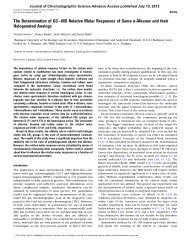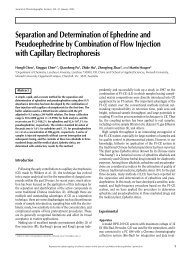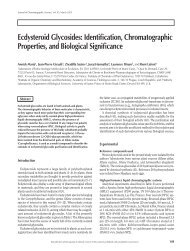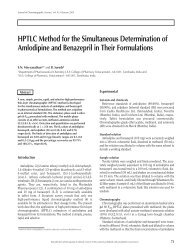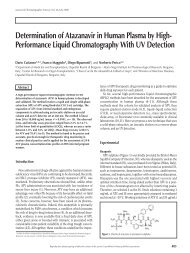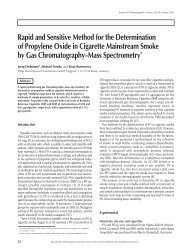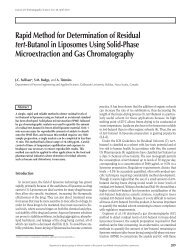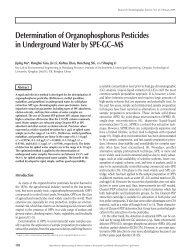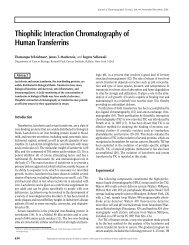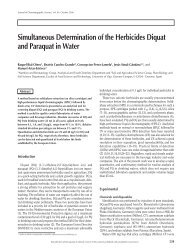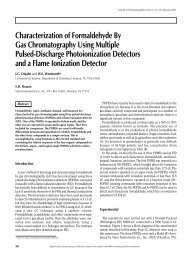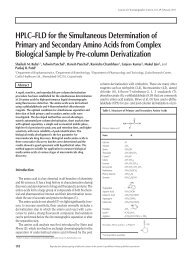Liquid Chromatography–Electrospray Ionization Ion Trap Mass ...
Liquid Chromatography–Electrospray Ionization Ion Trap Mass ...
Liquid Chromatography–Electrospray Ionization Ion Trap Mass ...
You also want an ePaper? Increase the reach of your titles
YUMPU automatically turns print PDFs into web optimized ePapers that Google loves.
Journal of Chromatographic Science, Vol. 46, January 2008<br />
LC–MS and LC–MS n analyses of substrate<br />
Full scan mass spectral analysis of scopolamine showed a<br />
protonated molecular ion of m/z 304 (Figure 1A). The MS–MS<br />
product ion spectrum of the protonated molecular ion (m/z 304)<br />
and its proposed fragmentation pathway are shown in Figure 1B.<br />
Scopolamine was eluted at 2.90 min under the experimental<br />
conditions (Figure 1C). Fragmentation of the protonated<br />
molecular ion of scopolamine in the ion trap led to five main<br />
product ions m/z: 286, 274, 156, 138, and 110. The product ions<br />
at m/z 286 and 274 were formed by the loss of H 2O and HCHO<br />
from the molecular ion at m/z 304, respectively. The most abundant<br />
product ion at m/z 138 was formed by the loss of tropic acid<br />
(C 9H 10O 3, 166 Da). The ion at m/z 156 was produced by the loss<br />
of C 9H 8O 2 (148 Da). The fragment ions at m/z 156, 138, and 110<br />
coexisted in the MS 3 spectra of m/z 286 and 274. It could be concluded<br />
that the ions at m/z 156 and 138 were a pair of characteristic<br />
product ions of scopolamine, and 148 Da and 166 Da were<br />
its characteristic neutral losses. These characteristic product<br />
ions and neutral losses were the sound bases to identify metabolites<br />
of scopolamine.<br />
Relative abundance (%)<br />
Relative abundance (%)<br />
Relative abundance (%)<br />
Relative abundance (%)<br />
m/z<br />
m/z<br />
m/z m/z<br />
Relative abundance (%)<br />
Figure 2. MS–MS product ion spectra of scopolamine and its 8 metabolites in rat feces.<br />
Relative abundance (%)<br />
Relative abundance (%)<br />
Relative abundance (%)<br />
Relative abundance (%)<br />
m/z<br />
m/z<br />
m/z<br />
m/z<br />
In vivo metabolism<br />
Identification of metabolites in rat feces<br />
Based on the method previously described, the parent drug<br />
and eight metabolites were found in rat feces after<br />
administration of scopolamine. Their protonated molecular ions<br />
([M+H] + ) were at m/z 142, 156, 272, 286, 290, 304, 320, and 336,<br />
respectively. The MS–MS spectra of these analytes were<br />
presented in Figure 2. Among them, the retention time (Table I)<br />
and the MS and MS2 spectra of the protonated molecular ion at<br />
m/z 304 (M0, Figure 2F) were the same as those of scopolamine.<br />
Therefore, M0 could be confirmed as the unchanged parent<br />
drug.<br />
The MS2 spectrum of m/z 156 (M2) was the same as the MS3 spectrum of the protonated molecular ion of scopolamine at m/z<br />
304 → 156, and there were the characteristic product ions at m/z<br />
98, 110, 138 in its MS2 spectrum (Figure 2B). So, M2 was<br />
identified as the hydrolysis product of scopolamine, and it was<br />
scopine.<br />
The protonated molecular ion at m/z 142 (M1) and its<br />
daughter ions at m/z 124, 114, 96, 84, and 70 (Figure 2A) were all<br />
14 Da less than m/z 156 (M1) and its daughter<br />
ions at m/z 138, 128, 110, 98, and 84, respectively.<br />
These results indicated that M1 should be the Ndemethyl<br />
product of M2 (norscopine).<br />
The characteristic product ions of m/z 110 and<br />
138 appeared in the MS2 spectrum of the protonated<br />
molecular ion at m/z 286 (M4, Figure 2D),<br />
which was decreased by 18 Da compared to that of<br />
the unchanged scopolamine.The result indicated<br />
that M4 should be the dehydrated metabolite of<br />
scopolamine (aposcopolamine). The m/z 268 ion<br />
may be produced by the loss of H2O from m/z 286<br />
via enolization.<br />
The protonated molecular ion at m/z 272 (M3)<br />
and its daughter ions at m/z 254, 124, and 96<br />
(Figure 2C) were all 14 Da less than m/z 286 and<br />
its daughter ions m/z 268, 138 and 110,<br />
respectively. Therefore, M3 could be identified<br />
as the N-demethyl product of M4 (aponorscopolamine).<br />
The m/z 254 ion may be produced<br />
by the loss of H2O from m/z 272 via enolization.<br />
The fragment ions at m/z 142 and 124 were produced<br />
by losing neutral fragments 148 Da and 166<br />
Da from the parent ion at m/z 290 (M5, Figure<br />
2E), which were the same as the neutral losses of<br />
the parent drug. It was obvious that the m/z 290<br />
ion and its daughter ions at m/z 272, 260, 142,<br />
124, and 96 were all 14 Da less than the molecular<br />
ion of parent drug (m/z 304) and its daughter ions<br />
at m/z 286, 274, 156, 138, and 110. Thus, M5<br />
could be identified as the N-desmethyl product of<br />
scopolamine (norscopolamine).<br />
The protonated molecular ion at m/z 320 (M6)<br />
was increased by 16 Da compared to that of the<br />
unchanged scopolamine. Because of the appearances<br />
of the characteristic fragment ions at m/z<br />
156, 138, and characteristic neutral losses 164 Da<br />
(148+16) (m/z 320 → 156), 182 Da (166+16) (m/z<br />
77



